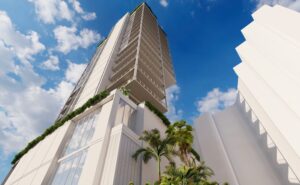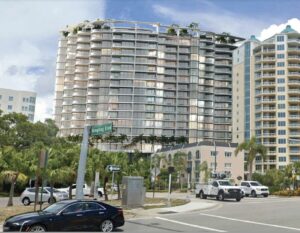Urban planners criticize shortcomings of downtown Sarasota developers, planning.
By Gretchen Cochran
Original Air Date: April 4, 2025
Host: Andrés Duany, the father of New Urbanism who helped give birth to Sarasota’s downtown development plan more than two decades ago, liked what he saw. But the current race for height in and around the city center is now prompting pushback among other architects and urban planners. WSLR News reporter Gretchen Cochran listened to the critics.
Gretchen Cochran: Brent Toderian had a few shocking things to say about downtown Sarasota recently. The former Vancouver planning director said, “Your tall buildings are fundamentally bad.” He called them “slabscrapers.” “They steal views and light,” he said.
He was invited here by Architecture Sarasota, one of three renowned urbanists from outside the United States, to give international perspectives on Sarasota and its prospects.
Toderian spoke February 25 at the Church of the Redeemer, right on the edge of Sarasota’s downtown. He had more to say about our tall buildings.

Bird’s-eye visualization of the proposed Adagio condo complex viewed from the south.
“There is a lack of activity at grade,” he said. That’s architect speak for ground level. He went on. “In essence the surrounding areas are windless. They are good examples of vertical sprawl.”
“Sprawl,” you know, is the pejorative word for not-very-good growth.
The audience was filled with city commissioners and local development decision makers. Squirms abounded.
He went on: “Your public spaces are impressive in quantity and quality, but your infrastructure is poor.”
Toderian was fired from his Vancouver job, possibly due to his brashness among other things, one local paper opined. Still, he went on to create Urban WORKS, a renowned global urban planning firm.
Sometimes people from afar can see things we, who are up close, cannot. But Andy Blanda, a Sarasota architect-designer and resident, and working in the field in Philadelphia for 30 years, has been sounding the alarm for awhile, referring in the Sarasota Herald Tribune to “the concrete canyon of buildings on 41.” (That’s Tamiami Trail.)
We sat down with Blanda at the one-story “shotgun” house he designed on a narrow lot in the Southgate area nine years ago. He’s been watching downtown’s development with concern.
Andy Blanda: We understand that development needs to happen, and planning needs to take into account more than just how the building fits on the site but how it affects the buildings around it and the streetscape around it. You can see that along Bayfront Drive is now a wall of buildings.

The Obsidian’s successor, 1260 North Palm Residences, faced much less pushback from city planners than the Obsidian.
GC: 18 stories is now what is allowed for new buildings downtown, he noted, mentioning the Obsidian, still in the permitting stages. The city should consider how these new high rises will affect the buildings around them and the streetscape.
AB: An 18-story building can now be much, much taller than you would normally see in an 18-story building. To me, that’s a loophole that really needs to be addressed downtown. The Obsidian will really throw a shadow over a great portion of downtown and also block the views of everyone behind it
GC: It’s like when you go to the movie theater and there’s someone taller than you, he explained. You move back and forth to see. Buildings can’t do that. So with the Adagio—proposed to go up on a block on the southern edge of downtown—there is a building quite shorter in the same block. That building is being devalued because of the building in front of it.

Visualization of the massive Adagio condo complex, as seen from US 41.
AB: I’m in the industry of building—or was, anyway, now that I’m semi-retired. Buildings will be built, but we need to address other things other than strictly the zoning code. We need to find a way to convince developers to look at more than what’s on their piece of land and look at the reaction—the effect of their building in the area around it.
GC: To be sure, Sarasota does know how to do things well. Blanda had an aerial photograph of downtown Sarasota and pointed to a specific area along the Boulevard of the Arts. Apartment buildings there are quite close to the street. You can see that they make a nice streetscape, being really tight to the sidewalk, not too tall but really dense. That’s what Sarasota should be aiming for.
He worries about Sarasota losing its sense of place—its connections to its past.
AB: Main Street used to be lined by oaks that were planted as a memorial for World War 1, and at the time, the merchants and the businessmen downtown said, “We need parking; we need this; we need that,” and the oaks were removed. Then someone decided they needed more room for parking and the oaks were removed. Things like that, I feel, are very short term thinking and need to be considered in the long term. What is the history of Sarasota that’s worth preserving?
He worries about working people, rather than the folks making a million or two the new high rises will accommodate in downtown.
That’s reminiscent of something the Canadian planner said back at the Architecture Sarasota talk:
“Your seashore is an asset people would kill for, but you have to froghop to get there. You can’t build enough units to make it affordable to be on the water. You need an overt strategy.” Then he added: “In our rules, we have a maximum number of units built under a mandate to build smaller, affordable units. You talk about incentives. We have barriers.”
This is Gretchen Cochran, reporting for WSLR.
WSLR News aims to keep the local community informed with our 1/2 hour local news show, quarterly newspaper and social media feeds. The local news broadcast airs on Wednesdays and Fridays at 6pm.